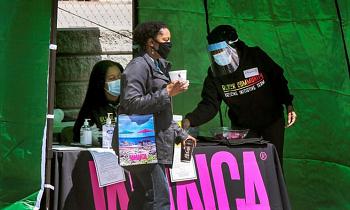Don’t mix households on May long weekend, warns Toronto’s public health chief, pointing to past COVID-19 case spikes
Relaxing COVID-19 restrictions too soon would sicken hundreds more Torontonians per day and extend the pandemic, warns the city’s public health chief.
Dr. Eileen de Villa revealed new COVID-19 projections Monday and pleaded with Torontonians, before the Victoria Day weekend, to break a cycle that sees holiday gatherings invariably trigger a spike in potentially deadly new infections.
De Villa made the comments in a morning briefing to the Toronto Public Health board and later at a COVID-19 briefing with Mayor John Tory.
“In general we are seeing some signs of improvement,” she said of the third COVID-19 wave that, fuelled by highly contagious variants, raged to mid-April pandemic highs in both virus spread and new hospitalizations.
Since the Ontario government applied “emergency brake” restrictions April 3, followed days later by a provincial stay-at-home order and then closures of some Toronto workplaces, the city’s main COVID-19 indicators have dropped — easing pressure on hospitals — but remain higher than at the peak of Wave 2.
“When our epidemiology team looks at the data, they specifically saw that the emergency brake actually resulted in a 43-per-cent reduction in transmission,” she said, adding the accelerating vaccine rollout is also taming once-raging variants.
“Toronto case rates continue to decrease,” de Villa said, “but remain far from safe reopening.”
She pointed to projections by York University’s Centre for disease modelling.
“If we’re able to maintain the current level of (personal) contact or interaction with each other, and therefore transmissions, we can actually still expect to see approximately 400 daily (new) cases by June 1,” she said. New daily cases have recently been in the 700 to 1,000 range.
But, if restrictions loosen enough to allow interactions and resulting transmission to rise by 20 per cent, computer modelling suggests daily new infections in Toronto would be about 800, or twice as high as with current restrictions maintained.
The Star reported Monday that the Premier Doug Ford government appears poised to extend the stay-at-home order for another two weeks, until June 2.
That calls into question Tory’s past hopes of launching CafeTO, the city program that allows use of curb lanes, sidewalks and other public spaces for restaurant and bar patios, in time for the May 24 Victoria Day weekend.
On CP24 Monday, Tory said it’s possible the province could allow some form of “modified” stay-at-home order. The current one prohibits patio and indoor restaurant dining.
De Villa warned of another long weekend consideration, urging Torontonians to not mix households, even as it appears they usually ignore such warnings.
Data shows spikes in infections after the Easter, Victoria Day, Labour Day and Thanksgiving weekends in 2020, as well as the Christmas break and Easter 2021.
“When we look at COVID case reports following long weekends and holidays it’s quite clear that, the more contact and the more interaction there is, then you can absolutely expect that in the days following, there will be increased cases reported in respect of COVID-19,” de Villa said.
She called the trend “not surprising” but urged pandemic-weary Torontonians to not risk prolonging lockdown by mixing households on the May long weekend.
Health board members also got data showing Toronto’s COVID-19 strategy of aiming vaccine supplies at virus hotspots is paying off.
Vaccination rates in the 13 hardest-hit postal codes caught up to the city average in late April and have since surpassed it.
The board voted to ask the Ford government to double the planned two-week period for aiming half of vaccine supplies at hotspot neighbourhoods, and also to scrap an order for the closure of outdoor recreation facilities.





